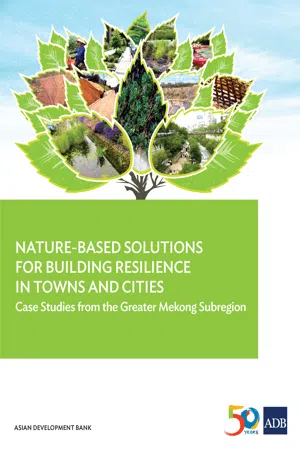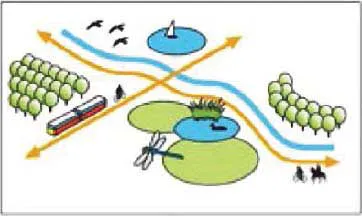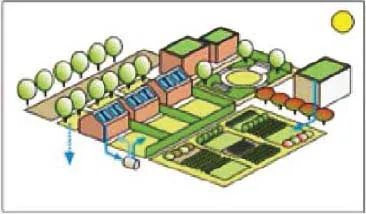![]()
Chapter 1
Nature-Based Solutions for Sustainable and Resilient Mekong Towns
1.1 Principles for Applying Green Infrastructure to Build Resilience in Mekong Towns
Green infrastructure10 refers to a strategically planned and managed network of green spaces and other environmental features and technologies necessary for the sustainability of any urban area.
Green infrastructure uses vegetation, soils, and natural processes to manage water, temperature, and air quality to create healthier, resilient, and beautiful urban environments. At the town scale, green infrastructure refers to the patchwork of natural areas that provides habitat, flood protection, clean air, clean water, food, and recreation. At the local level, green infrastructure includes stormwater and drainage management systems that mimic nature by soaking up and storing water and to improve its quality. For specific infrastructure systems, most importantly, it improves engineering by including natural components and bioengineering methods. At all scales, green infrastructure emphasizes nature-based solutions and uses of local resources and materials to build community self-reliance and resilience.
Examples of “green” infrastructure include green roofs and walls, hard and soft permeable surfaces, green streets, urban forestry, green open spaces such as parks, wetlands, and green drainage corridors. Green infrastructure also includes a wide range of green technologies for adapting and complementing buildings and infrastructure (such as roads, irrigation systems, floodgates, and canals) to be more efficient and to better cope with floods, storms, and heat. It covers natural water management systems, slope stabilization approaches, energy conservation measures, and many natural materials and techniques. Green infrastructure applies or mimics nature to improve the performance and resilience of conventional “gray” infrastructure and often can replace it entirely for much cheaper and stronger results that allow for local community monitoring, maintenance, and multiple uses. Green infrastructure planning should be the first step in the town spatial planning and development process and should be closely coordinated with planning for gray infrastructure. Integrated planning and design connects the two—gray and green—in a more effective, economical, and sustainable network.
Green infrastructure can contribute significantly to the delivery of other forms of infrastructure and services and should be given the same emphasis in planning and budgeting.
Ideally, the green infrastructure strategy for a town and specific green measures should be defined and mapped out before gray infrastructure options are considered and planned. In many situations, green infrastructure provides the best solutions to town development, leaving hard engineering to complement or make up any shortfall. If gray infrastructure is put in place first, it often rules out green options and reduces urban sustainability and resilience. For Mekong towns to function and develop effectively, green infrastructure needs to be treated as an essential accompaniment or alternative to conventional or “gray” infrastructure.
In summary, green infrastructure should
•be a foundation for planning, developing, and maintaining Mekong towns;
•be shaped by existing or past natural systems in the town area including its local landscapes, drainage patterns, habitats, and biodiversity;
•be a strategically planned and interconnected network set out in town master plans;
•be multipurpose, seeking to serve many functions and uses as well as building resilience in town areas and structures;
•involve local communities in design, construction, management, maintenance, and use;
•involve all relevant local authority departments in a coordinated and cross-sector manner; and
•be established permanently with financial support for continued maintenance and adaptation.
These points can be expressed as a number of foundation principles which should drive the introduction of green infrastructure and nature-based solutions to build ecological sustainability and climate change resilience in Mekong towns.
1. Green infrastructure should be the foundation for town planning and development
Green infrastructure should be planned and implemented as a foundation for sustainable and resilient town development. Like town electric power, transport, and telecommunication systems, the green infrastructure systems need to be planned comprehensively to provide ecological, social, and economic benefits, functions, and values. Green infrastructure needs to be integrated with development at all spatial scales: site, neighborhood, local, and regional levels. Green infrastructure is most effective when it functions at multiple scales.
2. Green infrastructure should be supported by a green plan
All Mekong towns require a formally adopted green infrastructure plan supported by design standards and development controls. The strategic planning of green infrastructure requires a coordinated approach involving a multidisciplinary team from a broad range of government sectors. Local authorities, national agencies, and major landowners will need to work with developers to prepare the strategy and supporting regulations. It will be required of national government infrastructure sectors in particular to respect and uphold town green plans within their own development plans and projects.
3. Green infrastructure should be applied through town zones and environmental impact assessment
All tools and procedures for shaping and assessing development proposals should be reviewed and revised to include green infrastructure safeguards and screening tools. All town development should proceed in a way that applies green infrastructure approaches consistent with the overall town green plan. Each town zone needs to be reviewed and accompanied by a framework of sustainability and resilience safeguards and development controls that promote green infrastructure. The environmental impact assessment process, which operates at the project proposal level, needs to include specific tools for ensuring that proposals embrace green infrastructure.
4. Green infrastructure systems should form connected networks across the entire town area
Green infrastructure systems should be developed as a strong green fabric or network which binds a town together. It should achieve physical and functional connectivity between sites at all levels and right across a town. Each item of green infrastructure needs to function as part of a larger network incorporating all the green spaces, features, and facilities of a town, both public and private. Green infrastructure systems help protect and restore naturally functioning ecosystems and provide a foundation for future development.
Connectivity may not always mean a direct physical connection between sites, although a physically joined-up network should be a priority—and may need to be established over time. Private land can also provide useful “stepping stones” in the green infrastructure network. Separate but closely colocated green spaces can still operate collectively in mitigating the effects of climate change and provide many ecosystem functions. The goal of all Mekong towns should be to eventually join up its green infrastructure network through a diverse arrangement of greening strategies.
The strategic connection of different system components—parks, preserves, riparian areas, wetlands, and other green spaces and technologies—is critical to maintaining ecological processes and services and to maintaining the health of the town’s residents and its biodiversity.
5. Green infrastructure should be implemented across different sectors and with communities
Green infrastructure requires close collaboration between developers, local planners, and affected communities. It should involve government, nongovernment organizations, and community groups representing interests as diverse as transport, water and waste management, biodiversity, food, health, and community development. All the local authorities within a town need to have a unified approach, to hold a common vision and be committed to implementing the same green strategy.
6. Green infrastructure should be multipurpose
Green infrastructure should provide outdoor spaces and facilities that are welcoming to local people and that meet a variety of human needs, including food, contact with nature, recreation and leisure, as well as safety. The green infrastructure network must provide a wide variety of spaces, habitats, and connections, supplying a broad range of fully integrated ecosystem services. It should support specific local priorities and strategies for environmental management—for example, energy efficiency, food production, and sustainable urban drainage. Multipurpose includes the provision of diverse products and services from agriculture, forestry and horticulture, renewable energy installations and fuel sources, climate change adaptation and mitigation, transportation routes, cycle paths and walkways, water management, recreational and sporting activity space, biodiversity, and aesthetics.
Multipurpose green infrastructure means taking an “ecosystem approach” to town development in which the management of land, water, and living resources is integrated to promote conservation and sustainable use. It also seeks equity among social groups and respect for cultural and socioeconomic diversity.
7. Green infrastructure should be financed a primary budgetary item for continued maintenance and adaptation.
Green infrastructure needs to be properly funded as part of a town’s core infrastructure, with provisions made for long-term maintenance and management. It should be funded up front with other essential services. That will require national and local governments to recognize green infrastructure and green plan implementation as a formal part of the regular budget allocation and priority setting.
Well planned green infrastructure decreases the costs of gray infrastructure and public services, including the costs for stormwater management and water treatment systems. Investing in green infrastructure can often be more cost-effective than conventional public works projects.
The functions, values, and benefits of green infrastructure are available for all town residents and visitors. Recognizing the public benefits of green infrastructure is an important first step in providing adequate funding.
1.2 Ten Strategies for Green Infrastructure and Nature-Based Solutions to Town Development
Green infrastructure complements, strengthens, and can replace hard infrastructure measures in Mekong towns. It acts to manage and conserve water and energy; reduce heat, flooding, and the impacts of natural disasters; and bring nature back as the foundation for urban development and life. Green infrastructure needs to become an essential ingredient in all Mekong town spatial plans and infrastructure projects. The goal is to achieve ecological sustainability and climate change resilience along with community well-being and safety, environmental quality, and beauty by seeking natural solutions to development challenges.
This section introduces 10 strategies for bringing nature back into Mekong towns as a core development goal. It requires the greening of town plans and modification of infrastructure design standards and controls to promote green infrastructure and nature-based solutions. It is both a town planning challenge and a challenge to the way infrastructure is currently planned, designed, and constructed in the Mekong region. The text and diagrams in this section are drawn from a web-based tool on urban planning prepared by the Royal Chartered Institute for Landscape Architects in the United Kingdom.11
1.Creating a fabric of interconnected green corridors and spaces: These should be the foundation for town development. Linking trees, parks, green areas, river valleys, wetlands, and drainage corridors with vegetated pedestrian walkways, cycle paths, and transport routes increases biodiversity and enables wildlife to flourish while building resilience to floods, drought, heat, and climate change.
2.Greening of core urban areas: Creating treed and vegetated streets and boulevards, green plazas, green roofs, and walls makes for attractive settings for shopping and leisure in the intensive use areas of towns and also improves the vibrancy of local economies. Street trees and green spaces provide cooling, shade, cleaner air, and noise reduction, making core urban areas more livable and bringing multiple economic benefits.
3.Greening of industrial and business zones: Attractive green settings encourage inward investment and establishment of new businesses. Industrial and business centers need to be carefully planned for sustainable and efficient transport, sustainable urban drainage, rainwater collection and wastewater cleansing, and reduced energy demands, all by applying green infrastructure and natural system solutions. This creates attractive and desirable workplaces and contributes to healthy local economies, reducing flood risk and climate change impacts and expanding the space for nature to thrive.
4.Beautiful, healthy, and green residential areas: Green spaces for recreation and healthy living encourage social interaction, neighborhood events, and food growing. Interconnected green spaces build community cohesion and identity, making settlements more functional and livable. Green space networks improve property values and reduce the effects of climate change, through natural drainage, renewabl...





